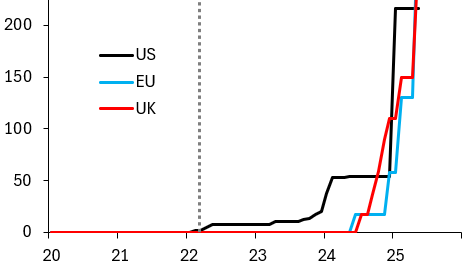The Race to Sanction Russian Oil Tankers
The vast majority of Western sanctions on Russian oil tankers only kicked in this year
Russia’s oil tankers are the lifeblood of Putin’s war economy. When Russia first invaded Ukraine, it was largely dependent on Western-owned tankers for its oil exports. The rapid growth of the shadow fleet has changed that, giving Russia the ability to ship around half its seaborne oil exports on shadow fleet ships, which operate outside the G7 price cap.
The EU and the UK this month unleashed a wave of sanctions on Russian-controlled tankers, bringing the total number of sanctioned vessels to 508, which - by any stretch of the imagination - is a very large number. Popular perception is that these sanctions don’t work well, which I address in today’s post.
One legitimate issue is that international coordination of sanctions is still woefully inadequate. Only 43 out of the 508 ships are sanctioned jointly by the EU, UK and US. Increasing the overlap of sanctions will maximize their effectiveness, so there’s lots of room for improvement here.
Another reason why popular perception of sanctions is negative is that they’ve been talked about for a very long time, but kicked in only this year in any kind of material way. As the chart above shows, it’s really only in 2025 that the EU, UK and US began to aggressively sanctioned Russian oil tankers. It’s far too early to be pessimistic. It’s simply too early to tell.
What evidence we do have on the effectiveness of sanctions - I’ll write about this tomorrow - is encouraging. US sanctions are highly effective at shutting down shadow fleet activity, while EU and UK sanctions - when applied jointly - also pack a punch.




Thks Robin, will wait till tmrw then to learn about inforcement and how they bite. Late on we need to speak about Frankfurt )aM( a truely undervalued city